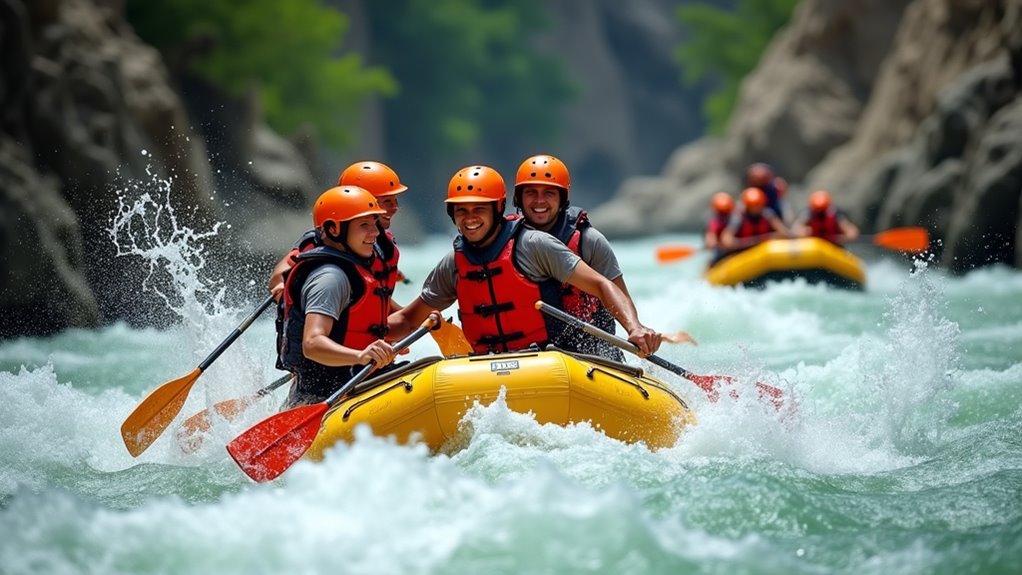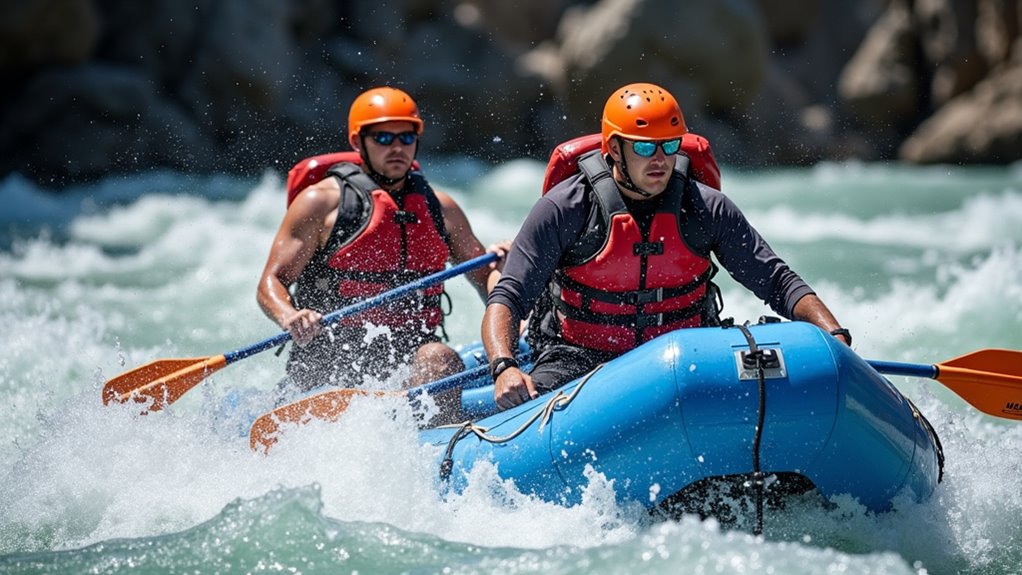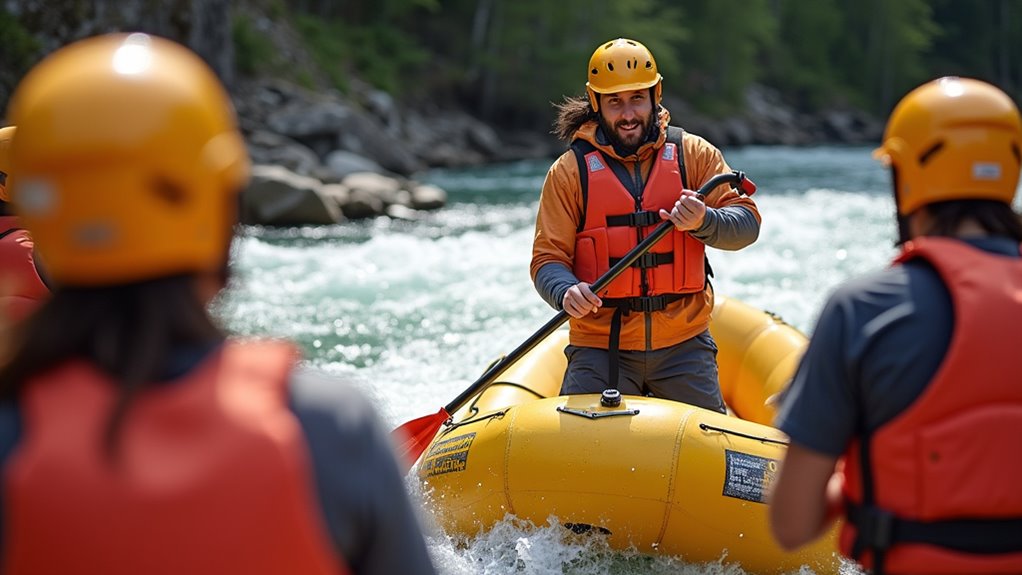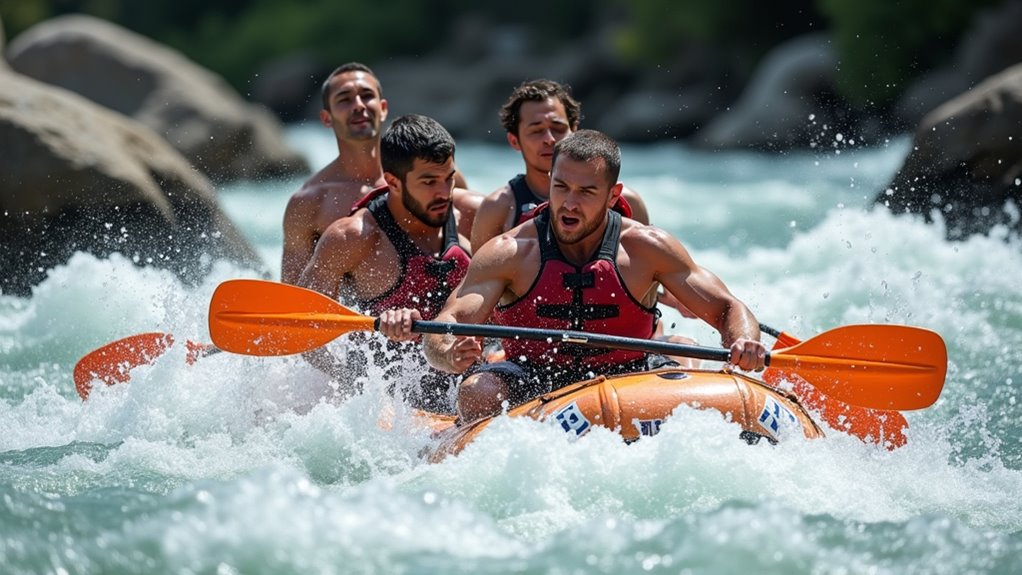Physical Address
304 North Cardinal St.
Dorchester Center, MA 02124
Physical Address
304 North Cardinal St.
Dorchester Center, MA 02124

Keep yourself safe while conquering wild rapids with these eight essential whitewater rafting tips that could save your life.
You’re drawn to the thrill of whitewater rafting, but safety concerns might be holding you back. That’s completely understandable – steering rushing rapids isn’t something you should take lightly. However, with the right preparation and knowledge, you can experience this incredible adventure while keeping risks to a minimum. The key lies in following proven safety protocols that experienced rafters have refined over decades. Here are eight essential tips that’ll transform you from a nervous beginner into a confident river navigator.

While whitewater rafting delivers incredible thrills, you’ll need proper safety equipment to protect yourself from the river’s unpredictable nature. Your personal flotation device (PFD) is non-negotiable—choose one specifically designed for whitewater that won’t ride up when you’re in the water.
When rapids get wild, your PFD becomes your lifeline—make sure it’s built for whitewater’s relentless power.
A properly fitted helmet protects against rocks and impacts, so don’t skip this essential piece.
Wear quick-dry synthetic clothing or neoprene wetsuit depending on water temperature. Cotton kills in cold water, so avoid it entirely.
Secure footwear with good grip prevents slipping on wet rocks. Consider neoprene booties for rocky rivers.
Pack a whistle for emergency signaling and ensure your gear fits snugly. Loose equipment becomes dangerous projectiles in rapids.
Quality gear isn’t expensive—it’s invaluable insurance for your adventure. Many outdoor enthusiasts combine whitewater rafting with rock climbing expeditions, making safety equipment selection even more critical for multi-sport adventures.
Beyond having the right equipment, you need to match your skills with appropriate river difficulty and stay informed about current water conditions.
Rivers are classified from Class I (easy) to Class VI (extreme danger). As a beginner, stick to Class I-II rapids with gentle currents and minimal obstacles. Intermediate rafters can handle Class III waters, while Class IV-V require expert skills.
Always check current conditions before launching. Heavy rainfall increases water levels and creates dangerous rapids. Cold water temperatures demand wetsuits and increase hypothermia risks.
Contact local outfitters, check online river gauges, and review recent weather patterns. Don’t let pride override safety – if conditions exceed your abilities, postpone your trip. Respect the river’s power and choose routes that match your experience level.
Professional guides provide essential safety tips and local expertise that can make the difference between an enjoyable adventure and a dangerous situation.

When you’re floating down the river with a professional guide, their instructions aren’t suggestions – they’re potentially life-saving commands that demand your immediate attention and response.
Your guide knows the river’s hidden dangers, best routes, and emergency procedures better than anyone. They’ll position you strategically, tell you when to paddle hard, and signal when to duck or brace yourself. Don’t hesitate or second-guess their directions – every second counts in challenging rapids.
In whitewater rapids, your guide’s split-second decisions can mean the difference between thrilling adventure and dangerous disaster.
Pay attention to these critical communication signals:
Trust your guide’s expertise completely. Their experience keeps you safe and ensures an unforgettable adventure. Before your trip begins, make sure you understand all the safety guidelines your guide explains during the pre-trip briefing.
Following your guide’s commands effectively requires you to know proper paddling techniques that’ll keep you moving in the right direction when it matters most. Hold your paddle with hands shoulder-width apart, keeping one hand on top and the other mid-shaft.
When you hear “forward paddle,” reach ahead and pull water toward your hips using your core muscles, not just your arms.
“Back paddle” means reverse this motion to slow down or move backward.
“High side” requires everyone to lean toward the raised side of the raft to prevent flipping.
“Get down” means drop into the raft immediately for safety.
Practice these commands during calm sections so they become second nature when navigating challenging rapids ahead.
Just like with scuba diving preparation, mastering these fundamental skills before you encounter difficult conditions will make your adventure both safer and more enjoyable.

Even experienced rafters sometimes find themselves in the water, so knowing proper swimming techniques can mean the difference between a minor mishap and a dangerous situation. When you fall overboard, don’t panic—your life jacket will keep you afloat. Point your feet downstream to protect yourself from rocks and obstacles ahead.
Follow these critical steps to stay safe:
Never try to stand up in moving water, as foot entrapment is extremely dangerous. Your guide will throw you a rope or paddle to grab. Colorado’s white water rafting opportunities provide excellent training grounds for practicing these essential safety skills with professional guides.
While you’re steering the rapids, you’ll need to keep your eyes constantly scanning the water ahead for potential dangers that could threaten your raft and crew. Watch for submerged rocks, fallen trees, and low-hanging branches that can puncture your raft or knock passengers overboard.
Look out for hydraulics – powerful water features that can trap rafts in dangerous recirculating currents.
Pay attention to sudden changes in water color, which often indicate depth variations or hidden obstacles. Sharp turns require extra vigilance since you can’t see what’s around the bend.
Communication with your guide is vital – they’ll spot hazards and call out paddle commands to navigate safely around them.
Stay focused and avoid distractions like taking photos during technical sections where quick reactions are essential. Understanding the top 5 dangers associated with whitewater rafting will help you recognize and prepare for the most common risks you may encounter on the river.

Although whitewater rafting doesn’t require Olympic-level athleticism, you’ll have a safer and more enjoyable experience if you’re in decent physical shape and can swim confidently.
Basic cardiovascular fitness helps you paddle effectively and recover quickly if you fall into the water. You don’t need to be a marathon swimmer, but you should feel comfortable treading water and swimming short distances in moving water.
Consider these fitness preparations:
If you’re not a strong swimmer, inform your guide beforehand. They’ll provide extra safety guidance and may position you strategically in the raft for maximum security.
Remember to pack essential first aid supplies in waterproof containers, as injuries can occur even during well-planned rafting adventures.
Beyond preparing your body for the adventure, selecting the right trip for your skill level and timing it with favorable weather conditions will set you up for success on the water.
Start with Class I or II rapids if you’re new to whitewater rafting. These gentler waters let you build confidence and learn basic techniques without overwhelming challenges.
Experienced rafters can tackle Class III-V rapids, but don’t jump skill levels too quickly.
Check weather forecasts several days before your trip. Heavy rainfall increases water levels and creates dangerous conditions, while drought can expose rocks and create shallow hazards.
Spring snowmelt often produces the most exciting runs, but summer offers more predictable conditions.
Book with reputable outfitters who’ll honestly assess whether conditions match your abilities. They’ll postpone trips when weather creates unsafe situations.
You’ve got everything you need to tackle those rushing rapids safely. Picture yourself confidently steering through churning white water, your paddle cutting through the spray as you work in perfect sync with your team. The theory that preparation equals confidence proves true every time you hit the river. Trust your gear, trust your guide, and trust yourself. When you’re properly prepared, those heart-pounding moments become pure exhilaration instead of fear.